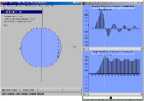
DspEdu 2.1
is an Educational Software Package in DSP with Six Modules Covering
1. Linear
Convolution of Two Finite Duration Sequences
2. Circular
Convolution of Two Sequences
3. Linear
Convolution from Circular Convolution
4. FFT and
Sampling of Fourier Transforms
5. Spectral
Analysis of Periodic Continuous Waveforms by FFT
6. FIR Filter
Design by Windowing
7. IIR Filter
Design by Analog to Discrete Transformation
8. Discrete-Time
Transfer Function Pole-Zero Analysis.

This Site
also contains a growing collection of Technical Articles written by Suresh
Kumar K.S on topics in Electrical Engineering.

Home
Convolve
Module
More
on Convolve Module
FFT
Module
More
on FFT Module
Spectral
Analysis Module
More
on Spectral Analysis Module
FIR
Filter Module
More
on FIR Filter Module
IIR
Filter Module
More
on IIR Filter Module
Transfer
Function Module
More
on Transfer Function Module
My
Technical Articles
Electrical
Power Systems |
From Home Page
of Suresh Kumar K.S , Assistant Professor in Electrical Engineering
NationalInstitute of Technology Calicut , Kerala State , India
|
DspEdu
v2.1 - "Transfer Function Analysis Module"
  
|
The "DTFA"
- Discrete-time Transfer Function Analysis - Module of DspEdu 2.1 covers
Frequency Response and Time Domain Response of Discrete-Time Transfer
Functions.The poles and zeros of transfer function can be assigned interactively
in a pole-zero diagram. It is also possible to load a discrete trasfer
function from a text data file. The frequency response is calculated by
the geometric distance in the z-plane method and animation shows the variation
of pole distances and zero distances in the pole-zero plot as the excitation
frequency point moves over 180 degrees on the unit circle.Time-domain responses
- impulse response and step response are also calculated and plotted.
DspEdu 2.1 is a Perl/Tk GUI
program for Windows Platform to help Students of Digital Signal Processing
at Engineering Undergraduate level in learning introductory DSP and experimenting
with basic concepts of DSP. Course Instructors will also find the program
of help in enhancing the effectiveness of their lectures by using the plot
displays from this program. There are six modules under this program at
present. More modules will be added in future and these modules will also
undergo revision.
This module covers the Frequency
Response and Time Domain Response of Discrete-Time Transfer Functions.
The user can enter the poles and zeros of the system interactively and
save the project file. The Frequency Response computation displays the
graphical interpretation in the Pole-Zero diagram.
Animation shows the variation
of pole distances and zero distances in the pole-zero plot as the frequency
response evolves in the upper semicircle of unit circle in the z-domain.
 

|
Download Information |
| DspEdu 2.1 is a Shareware. A feature
limited evaluation version is avilable for download from WinSite.Follow
the link below for the download file.
Download
Evaluation Version of DspEdu 2.1
The setup file installs the program
files , default project directories and the required Perl files and modules
under C:\DspEdu by default.DspEdu uses the Perl which gets loaded under
its installation directory even if the target system has Perl installed
in it. However , it does not affect the existing Perl installation , if
any. Neither does it modify any system settings or system files like autoexec.bat,
system.ini, win.ini etc.
The evaluation version allows 15 sessions for each module and each session is time-limited to 10 minutes. There are no feature-limits in the evaluation version.
|
| Registering DspEdu 2.1 |
The Main Control Panel of the program
has a 'Register DspEdu' button. Clicking on this brings up a dialog box.
Enter the Serial Number and the corresponding Key in the entry boxes provided
for the purpose and click on the OK button to register the program. Successful
registration creates a license file in the installation directory.
You can
obtain the Serial Number and Registration key from RegSoft.

Student
users from India can contact me over email for other payment options in
INR and discount options. |
Contact
Information
Suresh Kumar K.S
Assistant Professor in Electrical
Engineering
National Institute of Technology
Calicut,
Calicut-673601,Kerala,India
email - sureshks (at) nitc (dot)
ac (dot) in
Home Page - My
Official Home Page
Phone - 91-0495-2286334 |
|
Page Updated
on 3rd May 2004
©
2004 Suresh Kumar K.S
|
|

